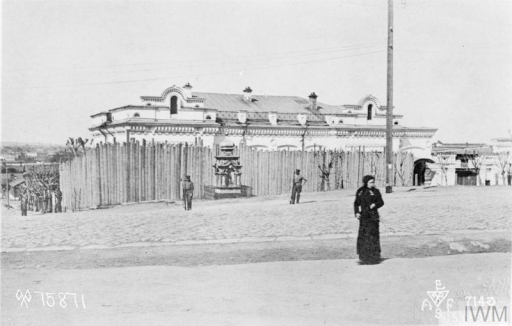Nicholas II, last Tsar of Russia and the first of Europe’s imperial rulers toppled in the Great War, was killed, together with his family, by Bolshevik revolutionaries on 17 July 1918.
The Romanovs met their deaths in the cellar of a house where they were being held at Ekaterinburg in the Urals.
According to accounts, they were shot and bayoneted in a bungled execution, and their bodies dumped in makeshift graves in forests outside the city.
Nicholas, his wife, the Tsarina Alexandra, their four daughters, – the Grand Duchesses Olga, Tatiana, Maria and Anastasia – and the Tsarevich Alexei had spent more than a year in detention since the Tsar’s abdication during the *February Revolution of 1917.
 Tsar Nicholas II (right) receiving a report at headquarters, 1915. That year he took over supreme command of Russia’s First World War armies from his cousin, Grand Duke Nicholas (Photo © IWM Q 53742)
Tsar Nicholas II (right) receiving a report at headquarters, 1915. That year he took over supreme command of Russia’s First World War armies from his cousin, Grand Duke Nicholas (Photo © IWM Q 53742)
Russia’s last royal autocrat was forced out by mass protests against wartime hardships in Petrograd (present-day St Petersburg).
Initially held at Tsarskoye Selo, a royal residence outside the capital, the family were moved to the Siberian city of Tobolsk in August by Alexander Kerensky’s Provisional Government as revolutionary unrest continued to grow.
Two months later, the Bolsheviks seized power in the October Revolution, taking Russia out of the First World War in March 1918 under the crushing terms of the Treaty of Brest-Litovsk.
At the end of April, the Romanovs were moved to their final destination in Ekaterinburg – a residence known as the Ipatiev House after its owner, and ominously renamed ‘The House of Special Purpose’.
Isolated
After the relative comforts of their earlier detention, the family were isolated and subjected to tougher personal restrictions. Wooden fencing sealed off the Ipatiev House from the streets, and its windows were painted out.
Exactly who ordered the deaths of Nicholas, Alexandra and their five children is still debated, but they were subsequently endorsed by Lenin, founder of the new Soviet state. In July 1918, Russia was engulfed in a growing Civil War, and anti-Bolshevik forces were advancing on Ekaterinburg.
The remains of the Imperial family were exhumed in the post-Soviet era. The last Tsar and Tsarina now rest with three of their daughters in the Saints Peter and Paul Cathedral, St Petersburg. The family have been canonised by the Russian Orthodox Church.
*Until 1918, Russia used the old-style Julian Calendar, so dates were 13 days behind those in West. Under the Gregorian Calendar, Nicholas II abdicated on 15 March 1917 and the October Revolution broke out on November 7.
See also in Centenary News:
The Kerensky Offensive – last major Russian attack of WW1.
Sources: Wikipedia/various
Images courtesy of Imperial War Museums, © IWM Q 70750 (Ipatiev House) & © IWM Q 53742 (Nicholas II at headquarters)
Posted by: CN Editorial Team
